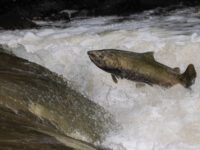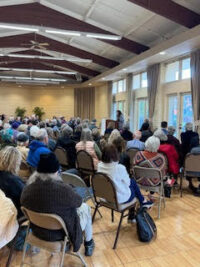The Sonoma Ecology Center (SEC) last Saturday introduced local homeowners, gardeners and conservation-minded citizens to four different models of successful water conservation being practiced in the Valley.
Beginning at MacArthur Place Inn and Spa in Sonoma, proceeding to Ernie Smith Park in El Verano, lunching at Benziger Family Winery in Glen Ellen and ending up at St. Francis Winery and Vineyard in Santa Rosa, participants of the “Water Wisdom Tour” learned about principles and techniques they can admire or adopt in their own lives.
Sonoma Ecology Center’s Water Wisdom Tour participants get close-up look at Benziger Family Winery’s recycling ponds. Photo by Bonnie Durrance/Sonoma Valley Sun.
Accompanying the group were SEC stewardship coordinator Julie Jehly, who arranged the tour; Dale Hopkins, watershed coordinator for the San Francisco Bay Regional Water Quality Control Board which provided the grant that made it possible; and the SEC’s restoration and stewardship program manager Lisa Micheli, a geo-morphologist who showed participants how to relate the specific lessons of water use to the larger context of water conservation in the Valley.
At MacArthur Place Inn and Spa, director of operations Kevin Virgo explained that solar heated pools and guest-requested laundry loads and steam rooms save copious amounts of water and cash. Guests do not object to the emphasis on conservation. “People are on the bandwagon,” Virgo said. “It’s good!”
At Ernie Smith Park, park representative Katja Svendsen showed participants how a wetland could grow out of a forgotten field thanks to “huge” community support. The wetland itself looked dry and weedy in the summer heat. Then one participant pointed and shouted, “Hey! There’s some water!” Everyone strained to see the tiny pool. Micheli explained that sedimentation is a big issue in the Valley and that the pool is no doubt much more shallow now than it was at the start. She explained that in drought conditions such as currently prevail, the sediment collects in the stream beds, forming shallow pools and “terrestrializing” the environment – turning what should be wetland into a tangle of weeds and making ongoing maintenance of such projects really important.
At Benziger Family Winery, Mimi Gatens, Director of Sustainability, talked about basic principles of “biodynamic farming,” a method based on the ideas of German philosopher Rudolf Steiner. “Everything we use to nourish the farm comes from the farm,” she said. For example, they bury a cow horn full of the winery’s own manure to produce soil that, they say, makes grape vines thrive. Also, they time their planting and pruning according to phases of the moon, in acknowledgement of its gravitational pull, so that newly planted roots, for instance, would be drawn into the earth and not pulled toward the surface. Even the compost pile is designed according to principles set up by Steiner, with herbs such as chamomile mixed in for balance. As the group relaxed in the patio shade nibbling on brown-bag lunches, Micheli lectured on the dynamics of the recycling ponds. Then, accompanied by the sounds of hens and sheep, lambs and frogs, they toured the series of recycling ponds that treat all the water that irrigates the vines.
Micheli gave her final lecture at Benziger, describing why conserving water is vital to the long-term sustainability of the Valley. “The Sonoma County Water Agency delivers 8,000 acre-feet of water a year through an aqueduct,” she told the group. “Most of the residential drinking water in the Sonoma Valley comes from the Russian River and is piped down here through the Sonoma Valley Aqueduct.” She explained that none of the river water goes to agriculture, that vineyards all have wells and that their use constitutes 70 percent of groundwater usage. “Cities, too, have large wells,” she said, “but these are used as back up. So everyone uses some form of combination of river and groundwater.”
“One of the big accomplishments of Sonoma Valley in the last couple of years,” said Micheli, “was developing the groundwater management plan.” This plan was a triumph because it required that a number of different groups share their information. For many, having a program that monitors water usage meant someone could come in and slap on a restriction. That was not the intention of the plan. “There’s no control on how much anyone uses,” said Micheli, “and what this plan is about is trying to develop a community based understanding of how much we’re drawing down our water table.”
The tour’s last stop was in Santa Rosa at the St. Francis Winery and Vineyard, which is just beginning its biodynamic conversion, and where the group would learn about water and winemaking and enjoy a complimentary wine tasting.
In a separate interview about the progress of the groundwater management plan, Mark Bramfitt, Director of the Valley of the Moon Water District, echoed Micheli’s expression of the importance of monitoring. “Recent work has shown that there’s a lot more salt water intrusion in the lower part of the Valley, and that it’s moving up Eighth Street at a faster rate than was known. [Consistent monitoring] has identified a new problem for us.” In addition to monitoring, the group has several other plans.
“One plan,” he said, “would involve taking reclaimed water out of the Eighth Street sanitation plant and instead of sending it all south into the Carneros and all the way over to Napa to help flush out the salt ponds, they would send some back and water the golf course and as many vineyards as possible. That,” he said, “would take a lot of pressure off of the ground water use.”
Then there is the possibility of getting a recycled water project going. “The Sanitation District, Sonoma County Water Agency, Valley of the Moon and the City of Sonoma are vitally interested in getting the recycled water project going,” he said. “And that is moving forward now. It’s down to the planning and let’s go start seeking the funding. We’re hoping to get some funding from the state.”
Another idea is groundwater infusion. “We’re drawing this water from the Russian river, we bring it down through a major aqueduct that serves the city and into the Valley of the Moon and it serves 90 percent of those two agencies. In the winter there’s tons of water in the river and the idea is ‘Why don’t we put some injection wells somewhere up-valley, maybe in Glen Ellen, and take this water and pump it into the ground.’”
“The question then is,” he said, “who would pay for it? Do I get to pull all that water out? Or do I save some of that for people who are relying on wells? I can’t send a bill to the people who are on wells. They’re not customers of mine. So it’s almost like the issue of the reclaimed water, which is how to establish a value that people are willing to pay that allows me to build that system and operate it and run it.”
Finally, he said, “I‘m happy to report that we decided that we’re going to offer our conservation services at least to people who are in or near our district who are on wells. And we recognize that VOM is partially reliant on groundwater so we have a responsibility to extend our conservation services. And we’re doing that now.”
“It’s the old issue of the commons,” he said. “People have to value what we all rely on.” At the end of the interview, as if answering the question everyone on the Water Wisdom Tour wanted to know, Bramfitt said, “It’s not difficult at all. I think the issue is, how do you pay for it?”







